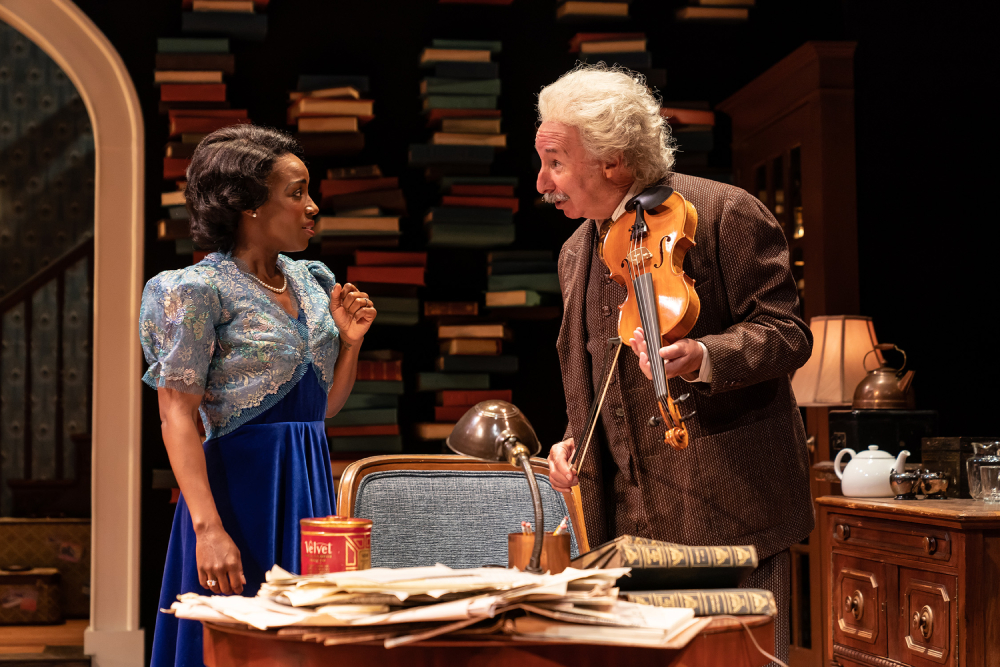Life
 "My Lord, What a Night" at Ford's Theatre, with wigs by Danna Rosedahl. Photo by Scott Suchman.
"My Lord, What a Night" at Ford's Theatre, with wigs by Danna Rosedahl. Photo by Scott Suchman.
Strand by Strand: Wig Makers Bring Theatre Characters to Life
September 1, 2022 @ 12:00pm
Anne Nesmith once constructed a towering white wig with a miniature ship perched on top. Another time, she fit a little pink faux hawk on a singer whose natural hair flowed to her waist. But the wig designer’s favorites are the ones you wouldn’t glance at twice on the street.
“I’m really proud of some of my work that just looks like someone’s hair,” Nesmith says. “Because that is the goal.”
Avid theatre-goers have most likely seen Nesmith’s work without ever putting a name to the hair. She’s designed wigs for major venues throughout the city: Signature Theatre, Arena Stage, Ford’s Theatre. And if she does her job right, tying hairs one by one and adding a delicate lace front to blend into the hairline, you might never know if an actor is wearing one of her pieces.
Wig making is a painstaking yet often invisible process, even though wig designers’ work is essential to theatre. As plays inch closer to their premieres, designers help bring a character to life.
“We’ve all done a pretty good job of creating whatever we’re creating here on stage. And then the icing on the cake is a wig,” Nesmith says. “Suddenly, you understand where you are and when you are.”
From Lace to Locks
Danna Rosedahl started by taping a bag on Christopher Bloch’s head.
As the wig and makeup supervisor for Ford’s Theatre, Rosedahl was responsible for making hairpieces for “My Lord, What a Night” last October. Bloch starred as Albert Einstein, and Rosedahl needed to recreate Einstein’s signature silver frizz for the play. First up: making a mold.
Nesmith says wig designers begin making molds by taping saran wrap or a bag over the actor’s head. They take measurements of the head as well, then transfer the base onto a wig block. Piecing together nets and lace over the mold creates the cap, the base of the wig.
“There are a lot of different ways that you can build a cap,” Nesmith explains. “It’s nice to have a bit of a stretch cap, but sometimes you’ll build a wig that is entirely on this more delicate lace.”
Rosedahl built the Einstein wig using a mix of nets and lace. She picked out the hair, mixing kinky and straight strands to give the character his chaotic look. Then came the time-consuming part: ventilation.
Ventilation is the process of tying each strand of hair, typically human hair, to the cap. In the back, designers sometimes knot multiple strands at a time, but toward the top and front, one strand of hair per knot creates the most realistic look.
Rosedahl spent about 40 hours ventilating Einstein’s wig — the equivalent of a full work week. Handmade work pays off, though. Machines just can’t produce the same result.
“The fronts never look good; they’re too uniform,” Rosedahl says. “That’s why you see all the videos of a girl who’ll buy a wig and then hand pluck the whole front because the machine doesn’t know how to do it randomly.”
Once the wig is ventilated, wig designers go to town. For Einstein’s hair, Rosedahl bought hair in the color she wanted. That’s what Nesmith does too. Neither are expert colorists.
But wig, hair and makeup designer LaShawn Melton dyes her wigs at this stage. To obtain certain shades, like the red undertones she wanted for the “On Your Feet!” tour, she says she needs to dye the hair herself.
“When I buy artificial or pre-colored hair, the texture, the quality is not the same as if I take some raw hair and color it,” she says. “It took me like three times to find the right shade in one particular week.”
Once the hair is colored, the designer cuts and styles it. There’ll be another fitting, and another, and maybe another. Wig makers want to be sure the wig fits well, the color looks right and the style is flattering.
When working on Einstein, Rosedahl wanted to get inside the scientist’s head in order to decide on styling his wig with pomade.
“I can’t imagine he showered every day because he’s too busy doing math,” Rosedahl says. “So, I tried to get it to look a little greasy at the root.”
One Piece of the Play
The process of designing Einstein’s wig didn’t start with that first fitting. It began months earlier, when a director and costume designer dreamed up their concepts for “My Lord, What a Night.”
Wig makers often don’t come on board until soon before a play premieres. That’s because wigs are so individually sized that designers need to measure the actors’ heads before starting on the wig — so they wait until actors are cast and in town for rehearsal.
It’s tricky work finding a balance between shortcuts and a natural look. Most of the time, Nesmith says she only has about a month to work her way from mold to complete look. Pulling pre-made wigs saves time.
Some theaters have stocks, but Nesmith has developed her own after 25 years in wig making. “I have a lot of wigs and just keep them in Ziploc bags sorted by color,” she says. Turned inside-out and braided, they keep for years.
The practical requirements of a play dictate material, not just time constraints. While the most realistic wigs use human hair, synthetic is a better choice for dance-heavy and outdoor productions, because it won’t fade in the heat.
And beyond the necessities of a production, every actor, director and costume designer on the play has their own opinion. Even if the wig designer and actor are convinced a blonde wig looks great, Rosedahl says the character’s hair could still end up brown.
“You can’t have an ego when you do wigs because you’ll think it’s great and it can get cut at any time,” Rosedahl says. “You just don’t take it to heart.”
Finding Their Place in Theatre
Daphne Epps had worked as a wig runner for years — helping actors put on wigs each night and cleaning them throughout a production — when she got a job on “Ain’t Misbehavin’.” She planned to buy wigs and style them for the musical, but one of the actors had long dreadlocks that a store-bought wig wouldn’t fit over.
Facing her first wig designing job, Epps went for a big hairstyle, with piles and piles of teased strands to help hide some of the bulk.
“Was it perfect? No. The stress that went into it, it was pretty intense. And it didn’t fit perfectly,” Epps says. “But I was proud that I manifested a product.”
Still a self-described “newbie,” Epps is trying to push further into wig making. But her route is far from the only path: Nesmith studied design and technical theatre. Rosedahl took an apprenticeship. Melton went to beauty school.
Each of them also had a reason for choosing theatre instead of working in a salon or with private clients. Epps loves the backstage vibes. Nesmith likes watching a character come alive. Rosedahl revels in the freedom of theatre. And Melton has ambition in spades.
“I always knew I wanted my work to be seen,” Melton says. “I knew I didn’t want to be a behind-the-chair stylist. I wanted my work to be seen by thousands, maybe even millions.”
Wig making for theatre may not be one of those careers kids dream of, but these designers found their ways into the industry and found incentives to stay: It’s calming. It’s creative. Designers have the power to make a character look beautiful or frightening or grim.
Even when she’s ventilating a wig, working strand by tedious strand, Nesmith finds something to love.
“I quite like to build [wigs]. Some people don’t because it is monotonous, and, I don’t know, it doesn’t seem like the most creative part of it,” Nesmith says. “But I really like that it is the start of something that’s going to appear transformative.”
See Nesmith’s wigs at annenesmith.com or @annenesmith1, and in theaters throughout the DMV. Melton’s work likewise appears throughout the DMV and is online at stylist1983.wixsite.com. Look for Rosedahl’s work at Ford’s Theatre and Shakespeare Theatre Company. Epps’ wigs appear in local theaters including Signature Theatre, Arena Stage and Hippodrome Theatre.







